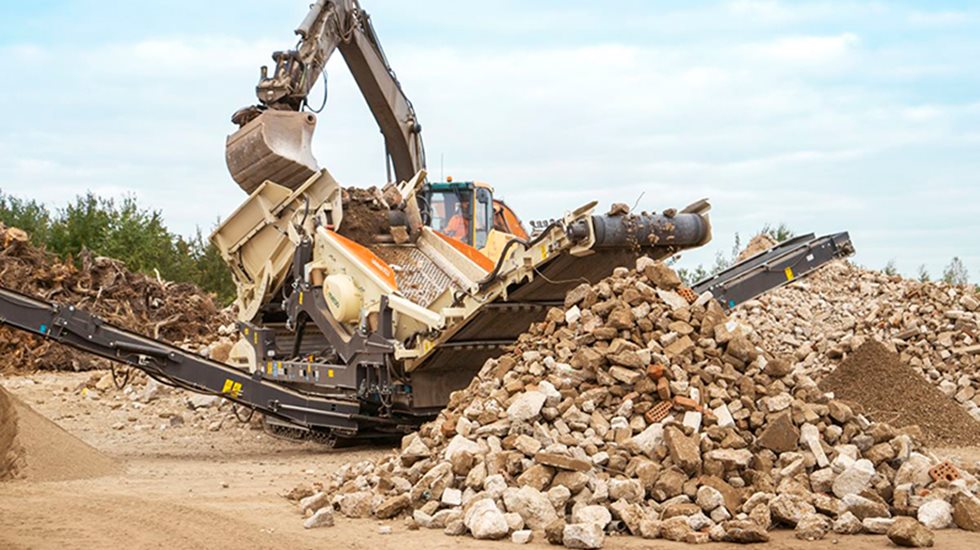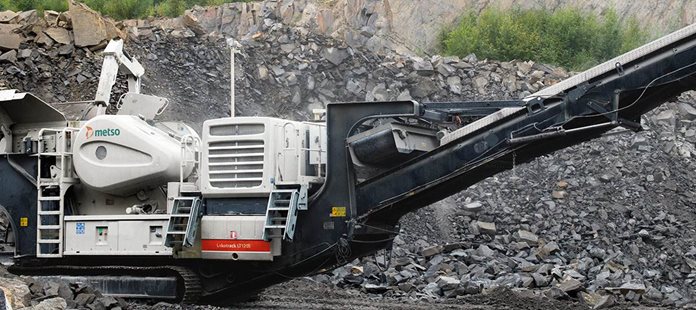-
What is recycled aggregate such as recycled concrete?
Recycled aggregate is waste material from demolished buildings or bridges, for example. When demolishing such structures, the waste needs to be sorted into wood, glass, etc. and concrete. This is called selective demolition, as the structure isn’t knocked down as a whole, but the materials are taken down selectively. Then, instead of dumping the concrete into a landfill, it is possible to reuse it after being crushed.
Usually, concrete contains rebar and other materials that strengthen it. Before being fed into a crusher such as the LT106 or LT1213/S that ultimately process it to a certain size and shape, concrete needs to be pulverized into a suitable size that fits into the crusher. During crushing, metal is separated with a magnetic separator.
-
What is driving the use of recycled concrete?
There are a lot of drivers for it, and they are ultimately creating opportunities for businesses. First of all, continuing urbanization means more construction of new buildings and demolition of the older ones from their way. At the same time, sustainability is emphasized more than ever, deployment of natural resources and circular economy thinking is on the rise. There is a need for alternatives.
Countries have reacted to this by changing legislation to favor the use of recycled materials more and more. The recycling of construction waste started around the 1990s with Germany and Japan leading the way. The early use cases had little or no restrictions at all on what characteristics the used concrete should have. Nowadays, use cases are becoming more sophisticated, keeping in mind the required strength of the materials, for example.
As an example of the latest legislation, the EU set a directive in 2008 that called its member countries to recycle 70% of construction and demolition waste by 2020. In 2018, the percentage was at 50%, but with some countries reaching up to 90%.
In addition, the costs of dumping demolition waste are constantly growing. The costs become even more significant, when the transport distance is long. So, instead of paying to get rid of the material, it is possible to recycle and sell it and even make a profit.
-
What is recycled concrete used for?
As a rule of thumb, construction with recycled aggregates is no different from construction with gravel or rock aggregates. The characteristics need to meet the requirements of built structure, road or whatever the material is used for.
Crushed aggregate made of demolition waste, so concrete and bricks, can be used instead of fresh gravel and rock aggregates for bases of roads and sports fields, sound barriers and parking lots, to name but a few. Better load-bearing capabilities have been measured with thinner layer thickness when crushed concrete was used. One other good example is the use of crushed concrete as riprap erosion control.
-
What are the benefits of using recycled concrete instead of natural rock?
Using recycled concrete saves both the environment and money.
As mentioned above, with recycling we can consume less raw materials and preserve gravel resources. Also, depending on the chosen equipment, there can be less transportation needs, which means lower fuel consumption. For example, with Lokotrack mobile crushers, crushing can be done on-site and material can be used there again as filling material, for example. That would mean also that less material goes to waste and ultimately, less dumping ground space is needed.
Cost savings come from the same aspects: less transportation means less fuel costs and eliminating the waste material means that there are no costs associated with dumping.
-
What things should be considered when crushing concrete?
Sorting is crucial for a successful recycling operation. Uncrushable materials must be pulled out from feed material. For example, rebar longer than feed opening (max. rebar length about 500 mm) and thicker than the minimum setting must be removed (max. rebar diameter about 20 mm).
In some of our Lokotrack models with jaw crushers, we have an ASC (Active Setting Control) system as an optional feature to protect the crusher against overloading. If an uncrushable object enters the crusher cavity and crushing forces reach the preset maximum level, oil starts to escape out of the cylinders and the setting releases. This way the uncrushable object can get out of the cavity.
The functionality enables continuous crushing and protects the crusher from extreme overloads. When automated, the crusher setting is returned the original one when the uncrushable object has dropped out of the cavity. It also means the same crushers can be used in different and multiple applications, such as heavy recycling, slag and foundry water, or industrial minerals.
For optimal capacity, it is also important to make sure that the feed material is of the correct size. Here the basic crushing principles with different crushers should be taken into consideration just like with any other feed material.
-
How does the future of recycled concrete look like?
Bright, without a doubt. Recycling is the most sustainable way forward and the most viable. As we’ve seen already, both legislation around the world and the development of technology really build up opportunities for this industry.

